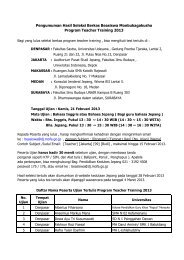9700_y16_sy
9700_y16_sy
9700_y16_sy
You also want an ePaper? Increase the reach of your titles
YUMPU automatically turns print PDFs into web optimized ePapers that Google loves.
Cambridge International AS and A Level Biology <strong>9700</strong> <strong>sy</strong>llabus Syllabus content<br />
3 Enzymes<br />
Enzymes are essential for life to exist. Their mode of action and the factors that affect their activity<br />
are explored in this section. Prior knowledge for this section is an understanding that an enzyme is a<br />
biological catalyst that increases the rate of a reaction and remains unchanged when the reaction is<br />
complete.<br />
There are many opportunities in this section for candidates to gain experience of carrying out practical<br />
investigations and analysing and interpreting their results.<br />
Candidates will be expected to use the knowledge gained in this section to solve problems in familiar and<br />
unfamiliar contexts.<br />
Learning outcomes<br />
Candidates should be able to:<br />
3.1 Mode of action of enzymes<br />
There are many different<br />
enzymes, each one specific<br />
to a particular reaction. This<br />
specificity is the key to<br />
understanding the efficient<br />
functioning of cells and living<br />
organisms.<br />
a) explain that enzymes are globular proteins that catalyse<br />
metabolic reactions<br />
b) state that enzymes function inside cells (intracellular enzymes)<br />
and outside cells (extracellular enzymes)<br />
c) explain the mode of action of enzymes in terms of an active<br />
site, enzyme/substrate complex, lowering of activation energy<br />
and enzyme specificity (the lock and key hypothesis and the<br />
induced fit hypothesis should be included)<br />
d) investigate the progress of an enzyme-catalysed reaction by<br />
measuring rates of formation of products (for example, using<br />
catalase) or rates of disappearance of substrate (for example,<br />
using amylase)<br />
3.2 Factors that affect enzyme<br />
action<br />
Investigating the effects of<br />
factors on enzyme activity<br />
gives opportunities for<br />
planning and carrying out<br />
experiments under controlled<br />
conditions.<br />
a) investigate and explain the effects of the following factors on<br />
the rate of enzyme-catalysed reactions:<br />
• temperature<br />
• pH (using buffer solutions)<br />
• enzyme concentration<br />
• substrate concentration<br />
• inhibitor concentration<br />
b) explain that the maximum rate of reaction (V max<br />
) is used to<br />
derive the Michaelis-Menten constant (K m<br />
) which is used to<br />
compare the affinity of different enzymes for their substrates<br />
c) explain the effects of reversible inhibitors, both competitive<br />
and non-competitive, on the rate of enzyme activity<br />
d) investigate and explain the effect of immobilising an enzyme in<br />
alginate on its activity as compared with its activity when free<br />
in solution<br />
Back to contents page<br />
www.cie.org.uk/alevel<br />
21





